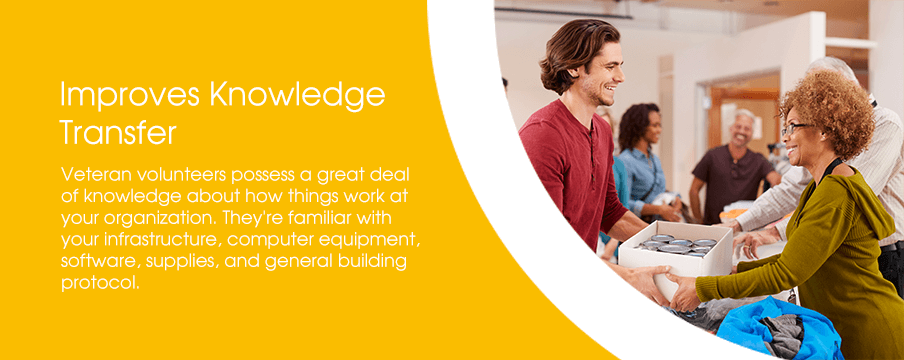Volunteer training via peer mentorship is quickly gaining popularity across several industries. Shaking up the traditional volunteer orientation, these mentorship programs offer an alternative to training, courses, or compliance classes for new volunteers.
How do you develop a volunteer mentoring program that both engages and educates? Is the planning worth it? Explore the insights and steps in this guide to see for yourself.
Benefits of Mentoring Within Volunteer Organizations
Understanding the advantages of peer mentoring will help you shape a program that works best for your nonprofit or organization — one that’s most likely to bring about positive change.
Creates More Effective Training
Ever heard of the 70-20-10 rule?It’s used in the fields of leadership and professional development to remind us that 70% of learning is best retained through actual experiential assignments — followed by 20% via interpersonal exchanges, and only 10% through formal courses.
In other words, people learn best with hands-on training and relationships, not rote instruction.
The maxim is a powerful motivator for starting a volunteer mentorship program. Compared to traditional training sessions, brochures, or manuals, volunteers will be more engaged and retain more critical role information through a hands-on mentor experience.
Fosters Social Connection
Volunteering at a new organization for the first time can be intimidating. People must adapt to pre-existing rules, workflows, and behaviors in a short amount of time, while also using their skills to make a valuable first impression.
With a peer mentor program, new volunteers have an instant connection to a veteran on the squad. The mentor provides guidance and counseling that speeds up the orientation process, while offering a welcoming, ongoing source of support. This connection makes their volunteer experience far more approachable, resulting in increased engagement and retention.
Improves Knowledge Transfer

Veteran volunteers possess a great deal of knowledge about how things work at your organization. They’re familiar with your infrastructure, computer equipment, software, supplies, and general building protocol.
Some of this knowledge can be taught, but most will be picked up organically over time. Through a formal mentorship program, veteran volunteers can pass along the unique knowledge they’ve learned on the job. These programs also allow for skill sharing and development. The knowledge transfer innate in peer mentoring also reduces volunteer burnout and turnover complications, where only a handful of “experts” shoulder the majority of responsibilities, but leave you high and dry when they’re not around.
Integrates Volunteers Faster
In corporate settings, over 80% of organizations manage some form of orientation program. Those with the most robust and dynamic interpersonal programs are shown to maintain stronger financial performances — plus higher employee engagement rates — compared to counterparts who focus only on technical courses.
Organizations likely experience these downstream benefits because peer mentors help new employees hit the ground running. With peer mentoring, training timelines shorten without sacrificing role preparation, allowing a new volunteer to contribute sooner. As a result, your organization experiences the benefits of their performance earlier. Plus, you can identify a new volunteer’s innate strengths, talents, and capabilities.
Improves Change Management and Turnover Pain Points
Building a sustainable, ongoing volunteer pipeline is one of the largest and most stressful responsibilities of a volunteer coordinator. Constant volunteer flux makes it challenging to organize shifts, often turning scheduling into a series of ad-hoc arrangements thrown together on a weekly, if not daily, basis.
Mentorship programs have a direct, positive influence on volunteer recruitment and engagement. When successfully implemented, they help secure the volunteers you already have, while simultaneously attracting more. Having a pool of dedicated volunteers makes scheduling shifts and tasks easier, resulting in less stress and overall program resilience.
Develops Trust
One hallmark of a healthy volunteer organization is a mutual sense of trust between employees and volunteers.
It’s easy for organizations — especially small or new ones — to slip into a helicopter mindset where organizers assign menial work for volunteers to complete one at a time. Those volunteers must then report back after every task, with limited room for feedback, development, or growth.
Peer management programs help break this culture by building real teamwork and camaraderie. Staff members can trust the mentor-mentee relationship will produce capable volunteers, which will ultimately speed up the journey toward value-additive contributions.
Sharpens Risk Management
Risk management for volunteer organizations can take many forms. Nonprofits, specifically, must adhere to a variety of practices and regulations prescribed by their 501(c) status, including rules about fundraising, sponsorships, gifts, and financial management.
What’s more, organizations and nonprofits must consider their own public image. A volunteer organization’s reputation consists of several factors, including the impact it has on the community, the way it treats constituents, and its interactions with staff and volunteers.
Peer mentorship models help ensure those interactions are as positive, productive, and welcoming as possible. You’re assured your organization puts its best foot forward with every volunteer that walks through your doors. Those volunteers will be far more likely to sing your praises in the community, boosting your reputation in an authentic, yet effective way.
Types of Mentoring Programs

Volunteer organizations have a few mentorship models to choose from when launching a new program. The three most common are:
1. Mentor and Mentee (1:1)
As the most traditional program type, this mentor-mentee initiative pairs a new volunteer with their own hand-selected mentor to show them the ropes. Participants are often matched based on similarities — background, age, interests, etc. — and meet one-on-one for formal and informal sessions.
Some of the benefits of mentor-mentee programs are that they:
- Assign a direct and immediate connection for new volunteers.
- Help develop confidence for both individuals.
- Increase volunteer retention rates.
- Boost mission and value buy-in.
- Provide a greater sense of purpose for mentors.
2. Peer-to-Peer
Peer-to-peer mentor programs are similar to traditional mentor-driven ones. However, new volunteers are explicitly paired with a veteran volunteer who has a similar age or status. This arrangement can alleviate some of the pressures and vertical hierarchies innate in a mentor relationship. Peer-to-peer programs also:
- Allow for more comfortable arrangements for young volunteers — teenagers, college students, etc.
- Align volunteers and mentors with similar skills, experiences, and interests.
- Provide a networking opportunity.
3. Group Mentorship
Finally, organizations may decide to create a group mentorship program. These arrangements may pair two or more new volunteers with a single, more experienced member. Or, the mentorship program can operate like a larger group meet-up, with all the fresh volunteers participating in co-training and organizational integration. The benefits of group mentorships include:
- Larger, more immediate social integration for volunteers.
- Richer group knowledge and skillset exchange.
- Less pressure placed on a mentor if two or more facilitators are assigned to run meetings.
How to Start a Volunteer Mentoring Program

Create a successful mentoring program for your volunteer organizations with this step-by-step guide:
1. Understand Your Why
Ask yourself why you’re initiating this program. You may find several answers fit your current needs:
- To holistically welcome new volunteers.
- To increase volunteer participation and retention.
- To improve knowledge sharing and maximize volunteer skills.
- To alleviate a volunteer coordinator’s training and onboarding burden.
- To reinvigorate your volunteer organization’s overall culture.
2. Define Ideal Objectives
The best mentorship programs have target outcomes. These outcomes, or end goals, help scaffold the curriculum and hands-on training sessions with relevant topics for your volunteers — yet remain manageable for the mentors themselves. Take care to define your program’s ideal outcomes, such as:
- Acquired skills: What skills will participants possess by the end of the program?
- Regulatory and compliance understanding: Are there regulations, laws, or provisions that volunteers need to know about to execute tasks or roles properly?
- End-date: Is there a definitive end-date for the program? Or, can mentors and mentees conduct ongoing collaborative work?
- Results: How will you measure the effectiveness of the mentorship? Consider anonymous or direct surveys, exit interviews, online questionnaires, etc.
3. Select a Mentoring Format
Make sure the mentoring program’s schedule isn’t too demanding or rigid. These are volunteers, after all. However, certain structures must be in place for mentors and mentees to step immediately into, ensuring the program’s smooth implementation. Some format considerations include:
- Group, peer, or 1:1 mentoring.
- Optional or mandatory participation.
- Open, invite, or application-only enrollment.
- Duration — days, weeks, months, or ongoing.
- Progress tracking and accountability methods.
4. Create the Program Outline
Mentoring outlines designate the key stages of the volunteer program. Think of it as a blueprint. The program’s major topical framework is there, yet outlines leave plenty of room for creativity and flexibility, based on a mentor’s discretion and the new volunteer’s needs.
Use your outline to set the following major program perimeters:
- Official mentoring program kickoff.
- Program schedule, key training dates, and topics to cover during volunteer shifts.
- Available support resources.
- Suggestions for informal meet-ups.
- Criteria to meet before graduating to the next training date or topic.
5. Select the Program’s Administrators
Volunteer managers or coordinators oversee the vast majority of volunteer mentoring initiatives. These members of your staff possess the expertise critical to shaping a functional and engaging program. However, they’re far from the only people whose insights will be instrumental in launching the new endeavor.
Using defined objectives and an official program outline, staff must ensure all stakeholders are aligned on the strategic value of the mentoring program. This includes discussing developments with a board of directors, plus any other major players who will be affected by a volunteer’s program development.
6. Attract Mentors
Mentors sit at the heart of your program. Like the new volunteers themselves, mentors should also have something to gain and learn while participating in your initiative. Ensure you’re broadcasting those unique benefits to attract the best and brightest potential mentors. Some benefits of being a mentor include:
- Gaining an opportunity to show leadership potential.
- Promoting community impact and change.
- Challenging yourself in a new position.
- Improving your personal skillsets and accomplishments.
You’ll also need to create an application form for volunteer mentors. These can be housed online or in print at your organization, mirroring your broader volunteer application forms. Ensure your applications give a clear and realistic mentor time commitment, plus participation benefits and any accolades or rewards a mentor might receive.
7. Attract Mentees
Mentees must be assured the volunteer program is more than just a dolled-up orientation. Participation will provide real, tangible insights and information, plus the confidence to dive into your organization and give back.
Make program sign-up as easy as possible for mentees. Similar to your mentor applications, provide a specific list of benefits participating mentees will get, including:
- Hands-on instruction on your organization’s operations.
- A direct contact to ask questions, seek guidance, and learn from.
- Easier social integration into the new organization.
- Increased confidence.
- Boosted skillsets, which can be applied in their professional and personal lives.
8. Determine Mentor-Mentee Matching Methodology
If you’re creating a 1:1 or peer program, consider how you’ll go about pairing ideal mentor-mentee matches. Have all applicants fill out a robust profile allowing them to describe likes, interests, hobbies, jobs, and personality details, as well as demographic information like age and gender.
Using those profiles, you can then sort matches in two ways:
- Self-matched pairs, where the mentors and mentees review profiles and submit top choices.
- Administrative-matched pairs, where you select pairs or groups based on profile data.
9. Prepare Program Resources
At this point, all major program scaffolding has been completed. You and your staff have aligned program goals and schedules with the broader needs of your volunteer crew. You’ve created applications, drafted participant benefits, and started broadcasting the new program across all relevant channels.
Use this time to finalize any remaining program resources for your mentors and mentees. This may include:
- Infrastructure, such as reserved rooms or space for meetings and training sessions.
- Technology, especially volunteer management software that coordinates mentor and mentee schedules and tracks program hours.
- Printed or digital program materials, especially any training modules.
- Additional program items, such as participant t-shirts, training snacks, coffee, etc.
10. Consider Mentor Training
Spend time at the conclusion of your planning process walking through the typical training session a mentor will facilitate. Have you prepared everything they’ll need for this responsibility? Do mentors know who or where to turn to with their own questions or concerns?
You may even look into holding an official mentor’s kickoff night, relaying tips and best practices for this new program. This way, fellow mentors can meet one another, learn program expectations, and ask questions. Even your most veteran program members will need support from time to time, too.
Empower Your Organization’s Volunteers

Volgistics’ industry-leading software serves as your central home for all things volunteerism. From scheduling hours to tracking mentor program completion and compliance to relaying communications, Volgistics can make your volunteer management tasks easier without missing a beat.
You can also stay engaged with the latest volunteer management tips, tricks, and expertise via our blog. To get the best software for organizing your mentoring program or other volunteer management tasks, contact Volgistics today.

